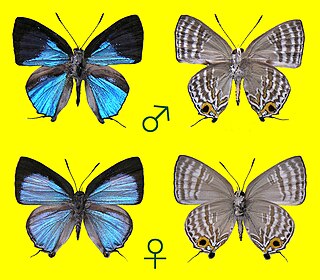
Sinthusa is a genus of lycaenid butterflies, the sparks. They are small species with the male genitalia and secondary sexual characters of Virachola, but less robust and weaker in flight. The males are easily recognized, with the forewings oily indigo blue changing to shining blue in a side light and hindwings shining violet blue in all lights. The species of this genus are found in the Indomalayan realm. The genus was erected by Frederic Moore in 1884.

Deramas is a genus of butterflies in the family Lycaenidae erected by William Lucas Distant in 1886. The genus ranges from south Myanmar to Sundaland, the Philippines and Sulawesi. Most of the species are rare and endangered, and are confined to forest from sea level to about 5,000 feet (1,500 m).

Drupadia is a butterfly genus in the family Lycaenidae. They are commonly known as posies. The members (species) of this genus are found in the Indomalayan realm.

Matsutaroa is a butterfly genus in the family Lycaenidae. It is nearest to the genus Ancema, but differs from it in the following points: (1) veins 5 and 6 on the forewing are not very close at their origins, but in Ancema they are very close at their origins; (2) the ground colour of the underside of the male is white, tinged with pale yellow and blue and has no shade of silver, but in the genus Ancema the ground colour of the underside is more or less tinged with silver; (3) in the male genitalia the valva is stout, a short brachial process is separating from the dorsum of the valva, and the phallus is stout, but in Ancema the valva is slender, a long brachial process separating from the ventral direction of valva, and the phallus is very slender.

Hypolycaena toshikoae is a butterfly of the family Lycaenidae first described by Hisakazu Hayashi in 1984. Forewing length: 10–13 mm. It is endemic to the islands of Luzon and Mindoro in the Philippines. On Mount Halcon of Mindoro island, the male is not rare but the female is very rare.
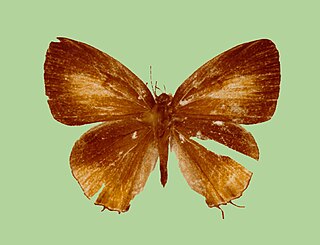
Hypolycaena irawana is a butterfly of the family Lycaenidae first described by Hisakazu Hayashi, Heinz G. Schroeder and Colin G. Treadaway in 1984. It is found in Palawan in the Philippines.

Paruparo mio is a butterfly of the family Lycaenidae first described by Hisakazu Hayashi, Heinz G. Schroeder and Colin G. Treadaway in 1984. It is endemic to the Philippine island of Mindanao. Forewing length: 16–17 mm. It is a quite rare species and the threat category is "vulnerable".

Dacalana mio is a butterfly of the family Lycaenidae first described by Hisakazu Hayashi, Heinz G. Schroeder and Colin G. Treadaway in 1983. Forewing length: 16–18 mm. It is rare species, endemic to the Philippines and found only on the islands of Mindanao and Leyte.

Arhopala tomokoae is a butterfly of the family Lycaenidae. Panchala paraganesa tomokoae H. Hayashi, 1976 was moved to Arhopala paraganesa tomokoae by Schröder and Treadaway in 1955 and its status changed to Arhopala tomokoae by Schrőder and Treadaway in 2002.

Pyroneura toshikoae is a butterfly of the family Hesperiidae. Its forewing length is 19–20 mm. It is endemic to the Philippines. It is very rare species and found only on eastern part of Mindanao Island.

Rapala tomokoae is a butterfly of the family Lycaenidae first described by Hisakazu Hayashi, Heinz G. Schroeder and Colin G. Treadaway in 1978. It is endemic to the Philippines. Its forewing length is 17–19 mm.
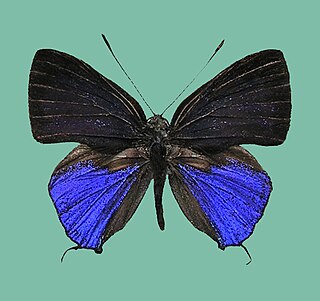
Sinthusa mindanensis is a butterfly of the family Lycaenidae first described by Hisakazu Hayashi, Heinz G. Schröder and Colin G. Treadaway in 1978. It is found on the Philippine islands of Mindanao and Leyte.

Rachana circumdata is a butterfly of the family Lycaenidae first described by Heinz G. Schroeder, Colin G. Treadaway and Hisakazu Hayashi in 1978. It is found on Marinduque in the Philippines.
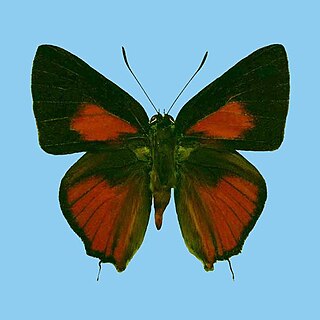
Deudorix philippinensis is a butterfly of the family Lycaenidae first described by Heinz G. Schroeder, Colin G. Treadaway and Hisakazu Hayashi in 1981. It is endemic to the Philippines where it is found on the islands of Luzon, Marinduque, Masbate, Mindoro, Panay, Negros, Sibuyan and Mindanao.

Dacalana liaoi is a butterfly of the family Lycaenidae first described by Hisakazu Hayashi, Heinz G. Schroeder and Colin G. Treadaway in 1983. Its forewing length is 17–18 mm. The species is endemic to the Philippines and distributed on Panay and Negros islands. It is not a common species.

Dacalana akayamai is a butterfly of the family Lycaenidae first described by Hisakazu Hayashi, Heinz G. Schroeder and Colin G. Treadaway in 1983. It is endemic to the Philippine island of Mindanao.

Dacalana irmae is a butterfly of the family Lycaenidae first described by Hisakazu Hayashi, Heinz G. Schroeder and Colin G. Treadaway in 1983. It is endemic to the Philippines and found only on Sibuyan Island. The forewing length is 17.5–20 mm.

Dacalana lucillae is a butterfly of the family Lycaenidae first described by Hisakazu Hayashi, Heinz G. Schroeder and Colin G. Treadaway in 1983. It is found only on Luzon island in the Philippines. The forewing length is 18–19 mm.
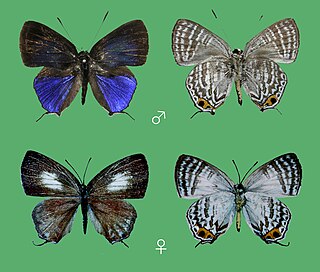
Sinthusa stephaniae is a butterfly of the family Lycaenidae. It is found on the Philippine islands of Mindanao, Leyte, Negros and Samar. Sinthusa mindanensis stephaniae was raised to species status as Sinthusa stephaniae by Colin G. Treadaway and Heinz G. Schröder in 2012. The forewing length is 12–15 mm. The habitat of subspecies S. s. stephaniae and S. s. mindanensis overlaps on the islands of Mindanao and Leyte.
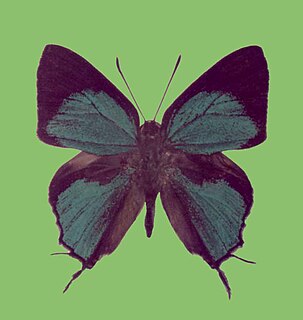
Paruparo cebuensis is a species of butterfly in the family Lycaenidae. It is found in the Philippines.



















